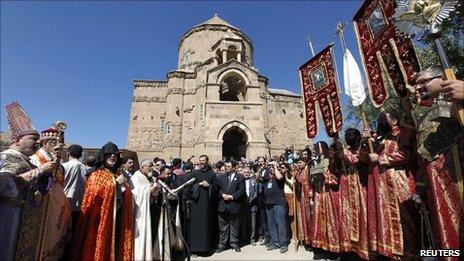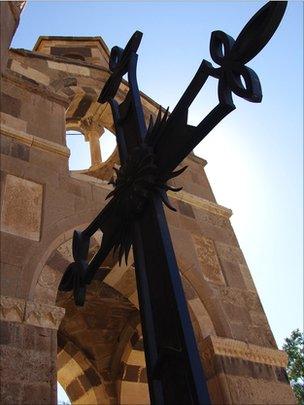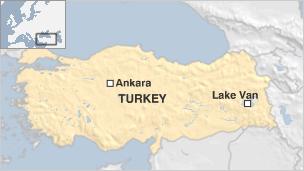Armenian church brought back to life
- Published

There had not been a service at the Church of the Holy Cross for the past 95 years
There can be few settings for a church as lovely as Akdamar island in Lake Van, Turkey, and few churches that fit that setting so well as the 1,100 year-old Armenian Cathedral Church of the Holy Cross.
With a backdrop of rugged mountains and the impossibly blue waters of Lake Van, it is a heavenly spot to hear a church Mass; and yet for the past 95 years, there had not been one, until Sunday.
Listening to the glorious sounds of the ancient Armenian liturgy in that setting was a profoundly moving experience; hundreds of Armenians had travelled, from Istanbul and also from the diaspora - from the United States, from Greece, Germany, even Armenia itself - to celebrate this symbolic reconnection with the land of their ancestors.
It was all the more moving, knowing they were praying among the ruins of the monastery - there was no room for them inside the 42-sq-m (452-sq-ft) nave of the church; the monks and priests were all killed in 1915, along with most of the population of the area.
The decision to allow the Armenian Patriarchate in Istanbul to hold a Mass there was made by the governing AKP, the party believes both in loosening restrictions on religion imposed by the secular state, and in improving relations with Turkey's minority groups.
"We believe that it is very important gesture towards freedom of faith," the provincial governor, Munir Karaoglu, told the BBC.
"Also we believe that it is important to eradicate the prejudices between the Turkish and Armenian people. It could also help improve relations Turkey and Armenia."
New beginning
Those who had chosen to come saw this as a positive step by Turkey towards confronting its history in this area.
"Let's just say that this is a beginning," said Harry Parsekian, a retired estate agent from Boston, whose parents escaped the Armenian killings.
"I hope the Turkish authorities realise that this is an opening - it's just a symbolic gesture right now."
For others, coming back was difficult. Paul Shahenian had never been to Turkey before. His family came from Van, and his grandparents barely escaped the mass slaughter which began in April 1915.
"Coming here is a bittersweet experience," he said.

The Turkish authorities have not allowed a cross to be erected on the church's dome for the service
"My parents are dead, my grandparents are dead, and I'm left with the memory of what this place was to them. Armenians were here for three millennia. Even if the Turkish government wanted to reconcile, I don't know how they would begin. So I think this is a very good first step."
Paul said there had been strong pressure on his family not to come from the rest of the Armenian community.
Many Armenians boycotted this service, either because they do not trust a government which will not acknowledge the 1915 killings as a genocide, or over the government's refusal to hand the church back to the Armenian Patriarchate.
It is still officially a state museum, and the authorities would not allow a cross to be erected on the dome for the service.
So the numbers were smaller than expected - a few hundred, rather than the thousands the local government had been hoping to welcome.
The crush of journalists and the crowds of curious local sightseers who had been encouraged to come to the island for the occasion also robbed it of any spiritual atmosphere.
'Be braver'
The church was built by the Armenian King Gagik in the 10th Century, and is the most complete ancient Armenian building left in Turkey.
As such it is very important to the Armenian community's sense of historical connection to this area - and that may be the reason the government is so wary of handing the church back.

Nationalists in Turkey still fear that Armenia has designs on their eastern provinces.
After all, the city of Van was briefly taken over by the Armenian community in 1915 after an armed uprising.
At the Treaty of Sevres in 1920, following the Ottoman defeat in World War I, the city was awarded to a new Armenian state.
It was only with the military successes of Turkish nationalists under Ataturk that the city reverted to Turkish rule.
"This government has been better than all the others," said Rober Koptas, editor-in-chief of Agos, the main Armenian newspaper in Istanbul.
"They renovated the church, which is great. But they must be braver. This was not enough. Most of Turkish society is ready to accept this is an Armenian church. Now it is the government's turn."
- Published19 September 2010